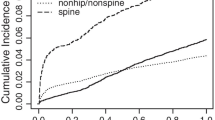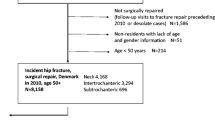Abstract
Summary
In a national sample of women veterans, the rate of lower limb fracture diagnosis was the highest across ages 18–74 years; rates of fracture diagnosis of other skeletal sites peaked in women aged 75+. Women with two or more primary care visits or mental healthcare visits had elevated odds of fracture diagnosis.
Introduction
We assessed the prevalence and healthcare utilization characteristics associated with a diagnosis of any fracture in women of all adult ages within the Veterans Health Administration.
Methods
In 344,488 women during fiscal year 2012, logistic regression models for fracture diagnosis included age, race/ethnicity, residence, number of primary care visits, number of mental healthcare visits, and degree of service-connected disability.
Results
Lower limb fracture diagnosis was most prevalent across ages 18–74 years and peaked in women aged 55–64 years. In women aged 75+, the prevalence rates of fracture diagnosis at the hip (102, 95 % CI = 88–115 per 10,000 women), upper limb (100, 95 % CI = 87–114 per 10,000 women), and lower limb (84, 95 % CI = 72–97 per 10,000 women) were the highest. Fractures at other skeletal sites peaked in those aged 75+ years. Black women had the lowest odds of a fracture diagnosis, followed by Asian/Pacific Islander and Hispanic women compared to non-Hispanic White (by 25–51 %, P < 0.05). Having two or more primary care visits or any mental health visit was each associated with an increased risk. Women with five or more primary care visits had a 3.36-fold (95 % CI = 3.02–3.75) greater odds than those with no such visit, and separately, women with five or more mental health visits had a 1.51-fold (95 % CI = 1.43–1.60) greater odds. Women with a fracture diagnosis had higher overall healthcare costs than those without (P < 0.001).
Conclusions
Prevalence of fracture diagnosis differed by age, race/ethnicity, and skeletal site of fracture. Fracture diagnosis may identify women veterans with greater overall healthcare needs.


Similar content being viewed by others
References
Cauley JA (2011) Defining ethnic and racial differences in osteoporosis and fragility fractures. Clin Orthop Relat Res 469(7):1891–1899
Cauley JA, Chalhoub D, Kassem AM, Fuleihan Gel H (2014) Geographic and ethnic disparities in osteoporotic fractures. Nat Rev Endocrinol 10(6):338–351
Barrett-Connor E, Siris ES, Wehren LE et al (2005) Osteoporosis and fracture risk in women of different ethnic groups. J Bone Miner Res Off J Am Soc Bone Miner Res 20(2):185–194
Bauer RL (1988) Ethnic differences in hip fracture: a reduced incidence in Mexican Americans. Am J Epidemiol 127(1):145–149
Cauley JA, Wu L, Wampler NS et al (2007) Clinical risk factors for fractures in multi-ethnic women: the Women’s Health Initiative. J Bone Miner Res Off J Am Soc Bone Miner Res 22(11):1816–1826
Cauley JA, Wampler NS, Barnhart JM et al (2008) Incidence of fractures compared to cardiovascular disease and breast cancer: the Women’s Health Initiative Observational Study. Osteoporos Int 19(12):1717–1723
Cummings SR, Melton LJ (2002) Epidemiology and outcomes of osteoporotic fractures. Lancet 359(9319):1761–1767
Wu F, Mason B, Horne A et al (2002) Fractures between the ages of 20 and 50 years increase women’s risk of subsequent fractures. Arch Intern Med 162(1):33–36
Kanis JA, Johnell O, De Laet C et al (2004) A meta-analysis of previous fracture and subsequent fracture risk. Bone 35(2):375–382
O’Neill TW, Cockerill W, Matthis C et al (2004) Back pain, disability, and radiographic vertebral fracture in European women: a prospective study. Osteoporos Int 15(9):760–765
The Veteran Population Projection Model 2014 (VetPop2014) (2014). http://www.va.gov/vetdata/Veteran_Population.asp. Accessed 29 Dec 2015
Zinzow HM, Grubaugh AL, Monnier J, Suffoletta-Maierle S, Frueh BC (2007) Trauma among female veterans: a critical review. Trauma Violence Abuse 8(4):384–400
Haskell SG, Gordon KS, Mattocks K et al (2010) Gender differences in rates of depression, PTSD, pain, obesity, and military sexual trauma among Connecticut war veterans of Iraq and Afghanistan. J Womens Health (2002) 19(2):267–271
Lehavot K, Hoerster KD, Nelson KM, Jakupcak M, Simpson TL (2012) Health indicators for military, veteran, and civilian women. Am J Prev Med 42(5):473–480
Das SR, Kinsinger LS, Yancy WS Jr et al (2005) Obesity prevalence among veterans at Veterans Affairs medical facilities. Am J Prev Med 28(3):291–294
Eisen SV, Schultz MR, Vogt D et al (2012) Mental and physical health status and alcohol and drug use following return from deployment to Iraq or Afghanistan. Am J Public Health 102(Suppl 1):S66–73
Frayne SM, Phibbs CS, Saechao F et al (2014) Sourcebook: women veterans in the Veterans Health Administration. Volume 3. Sociodemographics, utilization, costs of care, and health profile. Women’s Health Services, Veterans Health Administration, Department of Veterans Affairs, Washington, DC
U.S. Preventive Services Task Force (2011) Screening for osteoporosis: U.S. Preventive Services Task Force recommendation statement. Ann Intern Med 154(5):356–364
National Osteoporosis Foundation (2014) Clinician’s guide to prevention and treatment of osteoporosis. National Osteoporosis Foundation, Washington, DC
Maguen S, Ren L, Bosch JO, Marmar CR, Seal KH (2010) Gender differences in mental health diagnoses among Iraq and Afghanistan veterans enrolled in Veterans Affairs health care. Am J Public Health 100(12):2450–2456
Runnals JJ, Garovoy N, McCutcheon SJ, Robbins AT, Mann-Wrobel MC, Elliott A (2014) Systematic review of women veterans’ mental health. Womens Health Issues : Off Publ Jacobs Ins Womens Health 24(5):485–502
Banerjea R, Pogach LM, Smelson D, Sambamoorthi U (2009) Mental illness and substance use disorders among women veterans with diabetes. Womens Health Issues : Off Publ Jacobs Ins Womens Health 19(6):446–456
Bishop JR, Alexander B, Lund BC, Klepser TB (2004) Osteoporosis screening and treatment in women with schizophrenia: a controlled study. Pharmacotherapy 24(4):515–521
Mezuk B, Morden NE, Ganoczy D, Post EP, Kilbourne AM (2010) Anticonvulsant use, bipolar disorder, and risk of fracture among older adults in the Veterans Health Administration. Am J Geriatr Psych: Off J Am Assoc Geriatr Psych 18(3):245–255
Amin S, Achenbach SJ, Atkinson EJ, Khosla S, Melton LJ 3rd (2014) Trends in fracture incidence: a population-based study over 20 years. J Bone Miner Res 29(3):581–589
Melton LJ 3rd, Crowson CS, O’Fallon WM (1999) Fracture incidence in Olmsted County, Minnesota: comparison of urban with rural rates and changes in urban rates over time. Osteoporo Int: J Established Res Coop Between Eur Found Osteoporo Nat Osteoporo Found USA 9(1):29–37
Wright NC, Looker AC, Saag KG et al (2014) The recent prevalence of osteoporosis and low bone mass in the United States based on bone mineral density at the femoral neck or lumbar spine. J Bone Miner Res:Off J Am Soc Bone Miner Res 29(11):2520–2526
Office of Healthcare Inspections (2010) Healthcare inspection—management of osteoporosis in veterans with fractures. VA Office of Inspector General, Washington, DC
Singer A, Exuzides A, Spangler L et al (2015) Burden of illness for osteoporotic fractures compared with other serious diseases among postmenopausal women in the United States. Mayo Clin Proc 90(1):53–62
Frayne SM, Mattocks KM (2012) Sourcebook: women veterans in the Veterans Health Administration. Volume 2: sociodemographics and use of VHA and non-VA care (fee). Women’s Health Research Faculty Publications, Washington, DC
Author information
Authors and Affiliations
Corresponding author
Ethics declarations
Conflicts of interest
The authors declare that they have no potential conflicts of interest.
Funding
Women’s Health Evaluation Initiative, Women’s Health Services, Department of Veterans Affairs.
Disclaimer
The views expressed in this article are those of the authors and do not necessarily reflect the position or policy of the Department of Veterans Affairs or the United States government.
Rights and permissions
About this article
Cite this article
Chang, P.Y., Saechao, F.S., Lee, J. et al. Prevalence and risk of fracture diagnoses in women across the adult life span: a national cross-sectional study. Osteoporos Int 27, 3177–3186 (2016). https://doi.org/10.1007/s00198-016-3655-y
Received:
Accepted:
Published:
Issue Date:
DOI: https://doi.org/10.1007/s00198-016-3655-y




